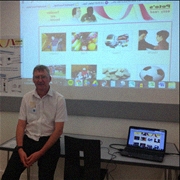Tutor HuntResources Special Needs Resources
Web Page Design And People With Learning Disabilities
Article discusses web page design for people with learning disabilities
Date : 17/10/2014
Author Information

Uploaded by : Peter
Uploaded on : 17/10/2014
Subject : Special Needs
Abstract:
The Internet may greatly facilitate the provision of acces¬sible information to people with learning disabilities. However, problems of navigation and, therefore, retrieval represent a barrier for this cohort. This article addresses one aspect of page design, testing whether a horizontal or vertical contents arrangement facilitates faster access to content for people with learning disabili¬ties. Participants were timed as they looked for one word "dummy" menu entries appearing in various locations along a horizontal or a vertical grid. The words corre¬sponded to images shown at random in a "word-search" type activity. Results were analyzed by using "mixed effects models." Results showed that mean search times increased as the position shifted from left to right and from top to the bottom. Thus, participants under¬took the test as if it were a reading exercise, despite the images appearing in the center of the page and the words appearing at random positions. The research also suggests that a horizontal menu may be more effective than a vertical one, with the most important links placed on the left. The propensity to imbibe information "seri¬ally" (word-for-word) rather than to skim or look "glob¬ally" has important website design implications.
Citation: The effect of web page menu orientation on retrieving information by people with Learning Disabilities Journal of the American Journal of the Association for Information Science and Technology
This resource was uploaded by: Peter
Other articles by this author
- Optimising website designs for people with learning disabilities
- Web site usability involving people with learning disabilities using only images and audio to
- Using electronic media for the teaching of basic skills at university
- Eliciting web site preferences of people with learning disabilities
